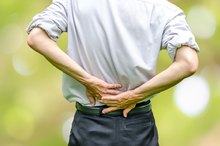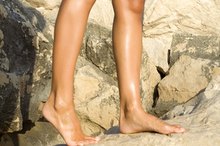How to Wear a Hernia Belt
The most common type of hernia that people experience is the inguinal hernia 1. Inguinal hernias occur in the lower abdominal/pubic area of the body, and are typically the result of a protrusion of abdominal contents (usually the intestine) through an anatomical defect in the abdominal wall 1. Many hernias require surgery at some point to repair the defect. But in some cases a hernia can be "reduced," or put back into place, and held by wearing an appliance called a hernia belt, or truss.
If you are experiencing serious medical symptoms, seek emergency treatment immediately.
Pick the right kind of hernia belt. Make sure the belt or truss has one or two hernia pads, corresponding to the nature of the hernia (one side versus both sides affected). Some underwear and wrap-around types come with two detachable pads so they may be placed on one side or both as the hernia type dictates. Having the proper appliance goes a long way toward success!
How to Wear a Truss for an Abdominal Hernia
Learn More
Apply the truss/belt according to the type of garment you have If it is a wrap-around variety, wrap it; with an underwear/jock strap version, slide it up or step into it. Make sure it is the proper size and there are no unwanted pressure areas anywhere.
Position the hernia pad(s) directly over the defect in the abdominal wall (hernia site). If the hernia is bilateral, be sure both pads are properly positioned and are indeed reducing the hernias.
How to Make Your Own Truss for a Hernia
Learn More
Secure the belt/truss against your abdomen in a gentle but firm manner, exerting just enough pressure to "push the bulge(s) back in." Once the hernia(s) have been reduced, secure the adjustment straps of the garment to maintain pressure.
Tips
Know your problem before using a hernia belt Proper pad positioning is critical to maintaining hernia reduction Belts and trusses can shift with time and movements. Check frequently for positioning
Warnings
Don't place pads on a non-reducible hernia, as it can cause tissue damage Don't over-tighten straps and place too much pressure on the hernia(s) Notify your doctor if the hernia fails to reduce, or fails to maintain reduction Discontinue use and call you doctor if you experience sudden, severe pain
Related Articles
References
- Inguinal Hernia
- Yoong P, Duffy S, Marshall TJ. The inguinal and femoral canals: A practical step-by-step approach to accurate sonographic assessment. Indian J Radiol Imaging. 2013;23(4):391–395. doi:10.4103/0971-3026.125586
- Harvard Health Publishing. Inguinal hernia. Updated July 2019.
- Lee SS, Jung HJ, Park BS, Son GM, Cho YH. Surgical Aspects of Recurrent Inguinal Hernia in Adults. Am Surg. 2016;82(11):1063–1067.
- Wang KS. Assessment and management of inguinal hernia in infants. Pediatrics. 2012;130(4):768-73. doi:10.1542/peds.2012-2008
- University of California San Francisco General Surgery. Inguinal hernia.
- National Institute of Diabetes and Digestive and Kidney Diseases. Inguinal hernia. Updated September 2019.
- Kulacoglu H. Current options in inguinal hernia repair in adult patients. Hippokratia. 2011;15(3):223–231.
- National Health Services. Inguinal hernia repair recovery. Updated June 14, 2018.
- Hernia. National Institutes of Health.
Tips
- Know your problem before using a hernia belt Proper pad positioning is critical to maintaining hernia reduction Belts and trusses can shift with time and movements. Check frequently for positioning
Warnings
- Don't place pads on a non-reducible hernia, as it can cause tissue damage Don't over-tighten straps and place too much pressure on the hernia(s) Notify your doctor if the hernia fails to reduce, or fails to maintain reduction Discontinue use and call you doctor if you experience sudden, severe pain
Writer Bio
Ken Chisholm is a freelance writer who began writing in 2007 for LIVESTRONG.COM. He has experience in health care, surgery, nursing and orthopedics as an orthopedic physician assistant and a registered nurse. He holds a bachelor's degree in business from the University of Findlay, Ohio.







